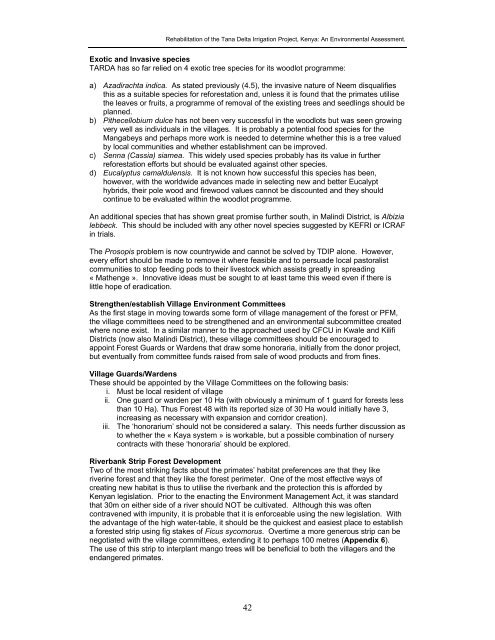Tana Delta Irrigation Project, Kenya: An Environmental Assessment
Tana Delta Irrigation Project, Kenya: An Environmental Assessment
Tana Delta Irrigation Project, Kenya: An Environmental Assessment
Create successful ePaper yourself
Turn your PDF publications into a flip-book with our unique Google optimized e-Paper software.
Rehabilitation of the <strong>Tana</strong> <strong>Delta</strong> <strong>Irrigation</strong> <strong>Project</strong>, <strong>Kenya</strong>: <strong>An</strong> <strong>Environmental</strong> <strong>Assessment</strong>.<br />
Exotic and Invasive species<br />
TARDA has so far relied on 4 exotic tree species for its woodlot programme:<br />
a) Azadirachta indica. As stated previously (4.5), the invasive nature of Neem disqualifies<br />
this as a suitable species for reforestation and, unless it is found that the primates utilise<br />
the leaves or fruits, a programme of removal of the existing trees and seedlings should be<br />
planned.<br />
b) Pithecellobium dulce has not been very successful in the woodlots but was seen growing<br />
very well as individuals in the villages. It is probably a potential food species for the<br />
Mangabeys and perhaps more work is needed to determine whether this is a tree valued<br />
by local communities and whether establishment can be improved.<br />
c) Senna (Cassia) siamea. This widely used species probably has its value in further<br />
reforestation efforts but should be evaluated against other species.<br />
d) Eucalyptus camaldulensis. It is not known how successful this species has been,<br />
however, with the worldwide advances made in selecting new and better Eucalypt<br />
hybrids, their pole wood and firewood values cannot be discounted and they should<br />
continue to be evaluated within the woodlot programme.<br />
<strong>An</strong> additional species that has shown great promise further south, in Malindi District, is Albizia<br />
lebbeck. This should be included with any other novel species suggested by KEFRI or ICRAF<br />
in trials.<br />
The Prosopis problem is now countrywide and cannot be solved by TDIP alone. However,<br />
every effort should be made to remove it where feasible and to persuade local pastoralist<br />
communities to stop feeding pods to their livestock which assists greatly in spreading<br />
« Mathenge ». Innovative ideas must be sought to at least tame this weed even if there is<br />
little hope of eradication.<br />
Strengthen/establish Village Environment Committees<br />
As the first stage in moving towards some form of village management of the forest or PFM,<br />
the village committees need to be strengthened and an environmental subcommittee created<br />
where none exist. In a similar manner to the approached used by CFCU in Kwale and Kilifi<br />
Districts (now also Malindi District), these village committees should be encouraged to<br />
appoint Forest Guards or Wardens that draw some honoraria, initially from the donor project,<br />
but eventually from committee funds raised from sale of wood products and from fines.<br />
Village Guards/Wardens<br />
These should be appointed by the Village Committees on the following basis:<br />
i. Must be local resident of village<br />
ii. One guard or warden per 10 Ha (with obviously a minimum of 1 guard for forests less<br />
than 10 Ha). Thus Forest 48 with its reported size of 30 Ha would initially have 3,<br />
increasing as necessary with expansion and corridor creation).<br />
iii. The ‘honorarium’ should not be considered a salary. This needs further discussion as<br />
to whether the « Kaya system » is workable, but a possible combination of nursery<br />
contracts with these ‘honoraria’ should be explored.<br />
Riverbank Strip Forest Development<br />
Two of the most striking facts about the primates’ habitat preferences are that they like<br />
riverine forest and that they like the forest perimeter. One of the most effective ways of<br />
creating new habitat is thus to utilise the riverbank and the protection this is afforded by<br />
<strong>Kenya</strong>n legislation. Prior to the enacting the Environment Management Act, it was standard<br />
that 30m on either side of a river should NOT be cultivated. Although this was often<br />
contravened with impunity, it is probable that it is enforceable using the new legislation. With<br />
the advantage of the high water-table, it should be the quickest and easiest place to establish<br />
a forested strip using fig stakes of Ficus sycomorus. Overtime a more generous strip can be<br />
negotiated with the village committees, extending it to perhaps 100 metres (Appendix 6).<br />
The use of this strip to interplant mango trees will be beneficial to both the villagers and the<br />
endangered primates.<br />
42

















